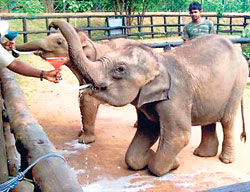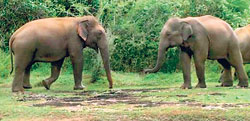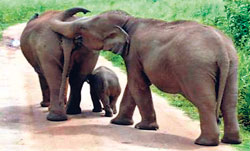The Uda Walawe Elephant Transit Home (UW-ETH) was established by the Department of Wildlife Conservation (DWC), under the guidance of Dr. N.A. Atapattu, Deputy Director, Veterinary & Research in 1995, to re-integrate orphaned and abandoned juvenile elephants back into the wild at the Uda Walawe National Park (UWNP). It was set up somewhat as a counter measure, to the ever expanding Pinnawala Elephant Orphanage (PEO), where the population was growing rapidly.
Unlike at the PEO, here orphaned elephants were to have limited interaction with humans, so as to enable them to be reinstated to the wild, at some point. The young are bottle-fed and then allowed to graze in a free-ranging fenced area, abutting the western corner of the reservoir. Thus, the elephants are allowed to feed and interact with each other, without much human interaction for most of the day except during feeding times and at night, when they are brought back into the central paddock.
 |
| Bottle feeding at UW-ETH |
The first batch of elephants from the UW-ETH, comprising three males and a female, were released into the wild in March 1998. Before release, generally, the elephants are first weaned, given a full meal early in the morning, and smeared with a paste made of dung and water to minimize the residual smell of humans.
Some of them are fitted with radio collars to enable them to be located after being released.
To date, 66 elephants have been released in eight batches, the largest being 11, and smallest being 4 (Please see table below). The last batch released was in June 2008, where eight elephants were released, all with radio collars. During the initial stages, under the supervision of Dr. Suhada Jayawardena – Veterinary Surgeon of the park, a reasonable good follow-up was conducted, with radio triangulation to locate the movements of the released elephants and periodic observations.
However, as in the case of PEO, unfortunately the follow-up, monitoring and scientific evaluation has been poor. Although, there are reasonable records of some released elephants, they are limited to where they were at particular times, and whether they were with another herd. More detailed observations have not been done on behaviour and sociological aspects, which are the most important areas of interest.
There is a record of one released female ‘Sandamali’, who gave birth to a calf in May 2005, after integrating well with a herd, and two young tuskers ‘Mahesh’ and ‘Senadhi’ who were released and integrated with a wild herd. There are other records and sightings of some of the released elephants being isolated, and even one case where a released elephant found its way back to the ETH. However, there is no detailed information or records of when, how, and under what conditions certain elephants have successfully integrated into herds, and why some have been rejected.
 |
| The ‘high caste’ elephants |
During a recent visit to the park, with Ashoka Ranjeewa, who is carrying out a research programme at UWNP (along with Shermin de Silva of the University of Pennsylvania), I came across a herd where we identified a released female, who seemed to have integrated well with the herd. She had recently calved, and according to Ashoka’s observations, the calf was about three weeks old. What was interesting was that this female seemed to be much more confident than any other females I have observed in the wild with a calf of this size. It is common knowledge that females guard a calf very protectively, even up to about four to five years of age. Many a time I have spent hours waiting for a good photo opportunity, but the mother and her entourage have successfully ensured that I could hardly see the calf.
In this case, the female was right in front of our jeep, with the calf close by her side without any concern. She then got on to the road with the calf in full sight. Then interestingly another young female joined her, and began pushing her away from our jeep. The released female with the calf reluctantly began to move forward, while this other elephant continuously pushed and prodded her, until she was off the road into the vegetation. We concluded that this could be that the other elephant was trying to shield her from us, while the female with the calf, possibly felt less threatened by us due to her early days interacting with humans at the UW-ETH.
Later on, I was also surprised to spot the entire ‘batch’ of elephants released in June 2008, together, on the Seenuggala road. All of them had their collars intact and seemed to be rather timid, keeping close to each other. Clearly, they had not integrated with another wild herd at all. They seemed to be in good health however, and it appeared that they had grown. (I was present at the UWNP during their release in June 2008). Inquiries revealed that the trackers knew about this and my concern was that no one seemed to be worried, that after one year, these elephants were still in one group. Has anyone studied what kind of trauma these young elephants are experiencing having been released into the wild and being rejected? I would reckon that three to six months is more than enough for elephants to integrate into another herd.
 |
| Protecting baby: These pictures from far left to right illustrate the behaviour of a she elephant brought up at the UW-ETH with her calf and another elephant who steered them away from the presence of humans at the Uda Walawe National Park |
This is the crux of the issue. Other than for sporadic checking of where the released elephants are, there is absolutely no scientific research or study being done as to why some individuals seemed to be accepted into a herd, while others are rejected. There is bound to be complex behavioural patterns to be observed and studied, given the highly complex social life of the elephants. There have been no records kept of what the structure of the herds, which accepted individuals into them were like, and what personality characteristics were prevalent.
On the contrary, in South and East Africa, such programmes are conducted under proper scientific management, which give rise to a wealth of information and learning.
I quote from the David Sheldrick Wildlife Trust Newsletter (2008) ‘The reintegration of a young elephant back into a wild community takes time and patience, for only when the elephant feels sufficiently confident to leave the human family, upon whom it has relied for protection for so long, and has made elephant friends in amongst the wild community, will the transition begin, and for a time there will be some to-ing and fro-ing between the human family and the wild friends. ……. besides which, after all, it is not possible to dump a human child of l0 into an unknown and hostile environment and believe that it will cope without psychological or physical damage. The same applies to elephants who are by nature fearful animals that rely heavily on the protection of the herd, and are emotionally bonded to “family.” Furthermore they make life-long friendships and like to stay in touch, and they also need the wisdom and discipline of their elders to grow up psychologically sound. Elephants are “human” animals in many respects, (with a few attributes that humans lack besides), something that has taken humans a long time to accept’.
At a ‘transit home’ “orphaned elephants could tend to be psychotic or neurotic due to unstable conditions drawing from trauma set back. This could have a great effect on their acceptance to a herd once in the wild” (Ref. David Sheldrick Wildlife Trust Newsletter 1999). Although human interaction at the ETH is said to be minimized, in reality the orphaned elephants would be forming some bonds with the keepers who feed them and provide them with some form of assurance at various times. It is an accepted fact, that given the strong maternal bonds a calf has, when orphaned it will undergo immense trauma and stress, which will certainly require a great amount of re-assurance and love. Hence, it may be that the degree of human association with the elephants at the ETH, although kept at a ‘minimum’, is of little consequence. (De Silva & De Silva 2007).
The successful programmes in Africa, on the contrary, rely on the concept of giving the newly orphaned elephant all the love and care it can get. A keeper is assigned full time, who actually acts as a surrogate mother. Often the keeper even sleeps close to the orphan during the early days! In fact, in Africa these facilities are called “Elephant Nurseries“ and not “transit homes“. Physiological depression and distress can trigger serious behavioral problems even later on in life in orphaned elephants (Post-Traumatic Stress Disorder- PTSD), and therefore it is of paramount importance to keep the calf as happy as possible during this period. Hence could this ambivalent practice of ‘minimal’ human interaction at the UW-ETH, have grave consequences on the behaviour of the calves later on in their lives?
In the African programmes for post release activity, pastoral communities such as the Masai and Sambur people, who have a good understanding of wildlife, are engaged to be a part of the monitoring team, which continuously tracks the elephants for months, until they are fully integrated with the wild herds. Here in Sri Lanka, even trying to locate the radio collared elephants, is a major chore for the resident vet, who has her hands full. To my mind, I guess several factors, such as the structure and the disposition of the herd, the personality of the individual (released) elephant, environment and food resources available would all be dependent factors to the success or failure of re-integration.
| Elephants released from the UW - ETH |
Batch |
Date |
Total |
Males |
Females |
1st Batch |
March 98 |
4 |
3 |
1 |
2nd Batch |
July 00 |
5 |
1 |
4 |
3rd Batch |
January 02 |
8 |
3 |
5 |
4th Batch |
June 03 |
11 |
4 |
7 |
5th Batch |
March 04 |
11 |
7 |
4 |
6th Batch |
April 06 |
9 |
4 |
5 |
7th Batch |
April 07 |
10 |
4 |
6 |
8th Batch |
June 08 |
8 |
2 |
6 |
Total |
66 |
28 |
38 |
At a recent presentation I made on ‘Wild Elephants’ for the National Trust of Sri Lanka, at the Barefoot Gallery, I touched on elephant castes, taken from Deraniyagala’s (1955) study on elephants, and to a question raised whether, the caste of an elephant has any bearing on the success of integration, I answered that the caste system of elephants had been imposed by man on the elephant, just like we do on ourselves.However, subsequently, I wondered whether there could be some truth to this. We had just seen a wonderful herd of elephants in the morning, by the side of the Seenuggala – Thimbiriyamankada road, out on the rock flats, and I could not help but admire the eight or nine individuals (with two majestic males in attendance). They were beautifully proportioned, healthy looking with hardly any blemishes.
Could this be perhaps a ‘high caste’ herd, which contrasts greatly from the somewhat ungainly looking, more ‘dwarf-ish’ looking (low caste?) herds also seen at the UWNP? These differences seem to be in the bone structure of the elephants, and not as a result of disproportionate food intake.
Could the ‘caste’ of a released elephant, or at least its physical characteristics and health, have some impact on its acceptance into a wild herd? I know, there is very little scientific backing to this theory, but all the same, it’s an interesting angle to this issue, given the immense folklore and mythological inter-connections that the elephant has had, for many centuries, with Sri Lankan history, culture and religion. Ayurvedha physicians and village elders in Sri Lanka will still tell you of the superstitions and ancient lore about a ‘Saddantha’ (high caste) elephant and a 'Gangeiya' (low caste) elephant. They will tell you about the 90 nerve centres of the elephant, some of which are so sensitive that, if prodded sufficiently deeply enough by the ankus, are supposed to cause death. So there could be many aspects to Asian elephant behaviour that we are still not aware of.
The point I am trying to make is that once again, we have lost the chance to undertake some high level scientific study on Sri Lankan elephant behaviour and re-integration into the wild. However, all is not lost, and it is still not too late for the DWC and perhaps some private interested individuals to get together and launch a proper study regarding the elephant integration that has taken place at UWNP. All it will take is patience and good prolonged analytical and detailed observations over a period of time, which could yield some very interesting outcomes.
(Courtesy GAJAH) |



